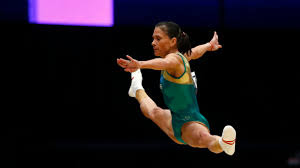Gymnastics season is upon us. With the 2016 Olympics on the way, it's the one time every four years you can find gymnastics on TV. After Sunday night's Olympic trials there is lots of talk and social media posts about the sport, which can be interesting and, for a former gymnast like myself, a tremendous time waster. Although I don't keep up with the sport like I used to, these last few days and subsequent web searches brought me up-to-date on all of the happenings. It's going to be an exciting Olympic games for gymnastics with a diversity of athletes to watch and teams to cheer for. Below you will find a few things to know and stories to look for during the games.
A-List Olympic Gymnastics Primer
2016 Olympic games marks 40th years since the first time a gymnast received a perfect ten. Romanian Nadia Comăneci achieved this distinction in 1976 Olympics in Montreal. Petite and only 14 years old, Ms. Comăneci demonstrated a magical combination of strength, elegance and daring that took her to the top of the sport. Despite a barely discernible hop at the end of her famous bar routine, her execution and skill level were beyond anything the world had seen before. To the judges, it was perfect. Many consider her to be responsible for the rise in gymnastics popularity world-wide and its transformation into a sport for women into a sport small, young and daring girls.
Those of us who followed Olympic gymnastics in the 80s and 90s will recall a glut of perfect10s in Olympic and world competitions. Routines that had obvious flaws were receiving perfect scores and a change was needed. In 2006 a new scoring system was adopted. This new system has athletes earning a possible ten points for execution and additional points for difficulty. The new systems rewards athletes for taking risks and adding difficult trick to their routines. If you want to find out more about the evolution of gymnastics scoring, check out The End of the Perfect 10: The Making and Breaking of Gymnastics' Top Score —from Nadia to Now by Dvora Meyers. I look forward reading Ms. Meyers' book, which makes the claim, among other things, that these changes in scoring will keep American gymnastics at the top of the sport.
 |
| Perfection |
Speaking of Romania, that country will not be sending a women's team to compete in this year's Olympic games. While I don't fully understand the process by which teams are selected, it has something to do with various world-wide competitions leading up to the Olympics. The Romania women weren't able to pull it to together in these events and will sit things out for the first time in 40 years. Cătălina Ponor came out of retirement to help her struggling team, but her valiant performance was not enough to earn them a spot. Ms. Ponor managed to turn in stellar performances and earned herself a change to compete in the all-around competition.
The teams to make the cut include:
- Belgium
- Britain
- Brazil
- Canada
- China
- France
- Germany
- Italy
- Japan
- Netherlands
- Russia
- United States
Age is Just a Number
It has long been that female gymnasts hope to fend off puberty in order to stay competitive in the sport. Although the age limit for competing in Olympics rose from 14 to 15 in 1981 and from 15 to 16 in 1997, in many ways gymnastics remains a sport for young, lean teenage girls. While it is not unheard of for gymnasts to compete in the Olympics in their early 20s, it is not the norm and we remember those that do (IE: American Kathy Johnson, age 24 in the 1984 Olympics).
Americans Gabby Douglas and Aly Raisman, ages 20 and 22 respectively, return for their second Olympics and are surrounded by teenage teammates. While not surprisingly old, they're not the epitome of the youthful gymnast and it is refreshing to see them on the team. In my recent web searches, I was pleased to find that Ms. Douglas and Ms. Raisman are no the only gymnasts holding on beyond their teenage years. I came across few other gymnasts listed below and I am sure there are others.
- Dipa Karmakar, age 22, represents India, the first woman to do so. Check out this video of this huge vault she pulls off.
- 26 year old Vanessa Ferrari, 2006 world all-around champion, will compete for Italy in her third Olympics.
- Romania's Cătălina Ponor is 28 and competes in her third Olympics.
- The woman who takes the prize is Uzbekistan's Oksana Chusovitina. At age 41 (That is not a typo!), Ms. Chusovitina returns for her seventh Olympic games. She has a fascinating story and a long and illustrious gymnastics career. She made the finals in vault in the 2012 Olympics and still competes in all apparatus at a level comparable to her teenage teammates.
 |
| Ms. Chusovitina in 2015 |
I hope the media will find the time to cover some of these athletes as opposed to focusing just on the top competitors and teams. Stories of underdog teams and unexpected stellar athletes can be just as interesting as stories of those at the top.
American Muscle
I didn't get to watch the Olympic trials, but I understand that the commentators boldly made the claim that the American team will dominate. America's leading athlete, Simon Biles, is a three-time world champion and one of only two women ever to pull off this feat. She will be the one to beat but apparently the rest of the team is strong as well.
Gymnasts have a well-deserved reputation for being lean but there is usually one star gymnast on any team that has a stocky, muscular build. Simone Biles (In middle of the photo) is a prime example of that build. What strikes me this publicity photo, which I love, is that all of the girls appear to be on the muscular side. Perhaps this is the result of clever photography but I hope I am wrong. Could this be a new trend and a new look in gymnastics? We shall see.
.



No comments:
Post a Comment